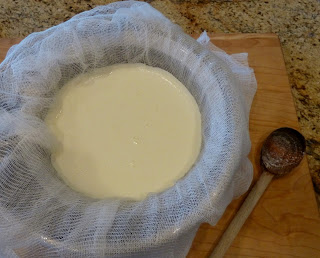Two Years Ago: Quinoa Stuffed Peppers
I recently gave myself a challenge to make spinach and ricotta cannelloni from scratch. I didn't go full-on crazy since I bought fresh pasta sheets from the store, but I did decide to make my own ricotta and grate my own Parmigiano-Reggiano and cook the spinach from fresh. Although the project took a few hours, it was fun and the results were spectacular. I'll post that recipe soon.
In the meantime, the fresh ricotta was such a revelation that I wanted to post it right away. I've never been a big ricotta fan because I've only used supermarket brands that are typically chalky and watery. Fresh homemade ricotta, in contrast, is very creamy and rich and as moist (or dry) as you want to make it. For example, if you want to use it as a spread on crostini, you might want to keep it more moist. For my cannelloni, I wanted it a little on the dry side so the filling didn't leak as the pasta baked.
It's incredibly easy to make - just heat some milk and cream with a little salt, add some lemon juice to curdle it, and strain it until it reaches your desired consistency, then refrigerate until ready to use. (You can make it a few hours or days in advance of the actual recipe where you want to use it.) Some recipes call for using vinegar to curdle the mixture, but the lemon juice really adds a nice subtle note - just be sure to use fresh lemon juice, not bottled. One note of caution - I've read comments that ultra-pasteurized organic milk will not curdle although I haven't tried it, so you might want to use milk that's not ultra-pasteurized.
Fresh ricotta has many uses, from appetizers to ravioli to lasagna. It's a way to up your game that will impress people no end, and no one needs to know how easy it is. I'll never buy ricotta again.
Fresh Homemade Ricotta
Yield: 1 1/2 - 2 cups (approximately 11 ounces)
3 cups whole milk
1 cup of heavy cream
1/2 teaspoon kosher salt or sea salt
3 tablespoons fresh lemon juice or white vinegar (lemon
juice is preferred for flavor, but vinegar can be used as long as it is a
neutral, white vinegar)
3 large squares cheesecloth
Prepare either a fine-holed colander or a fine-mesh
strainer by lining it with the layers of cheesecloth and placing it in a larger
bowl. Set aside.
In a medium, heavy-bottomed saucepan, heat the milk,
cream, and salt over medium heat just until it reaches 190 degrees Fahrenheit, stirring
occasionally to prevent sticking or burning.
Remove the pot from the heat and pour in the acid (lemon juice or
vinegar). Stir with a wooden spoon to
incorporate the acid well. Curds will start to form immediately. Let the mixture sit for about 5 minutes,
undisturbed, and then pour it into the prepared cheesecloth-lined colander or
strainer.
Let it sit, undisturbed, for anywhere from half an hour
(for a wetter, thinner consistency) to 2 hours (for thicker, creamier, dryer
ricotta). It depends on your preference and how you intend to use it. Check the
ricotta periodically to determine whether it has reached your desired
consistency and to drain the bowl if the liquid is getting close to the bottom
of the cheesecloth. As soon as the bowl
is cool enough you can transfer it to the refrigerator to finish straining
there.
When the ricotta is to your liking, scrape it into an
airtight covered container and refrigerate for up to several days.





No comments:
Post a Comment